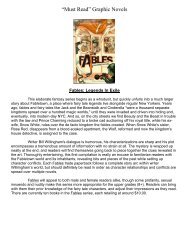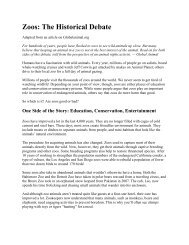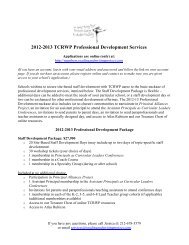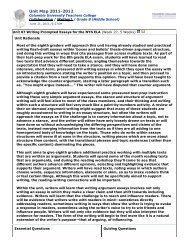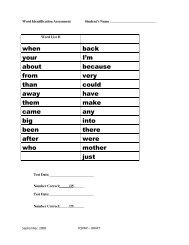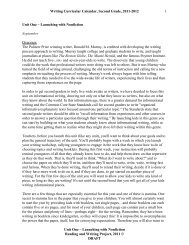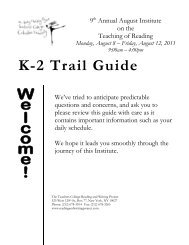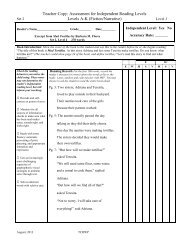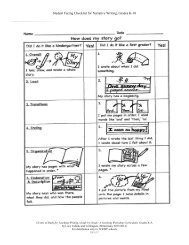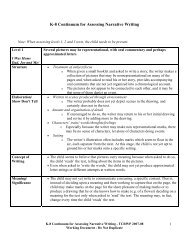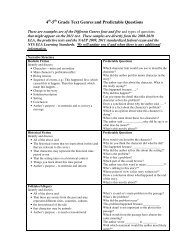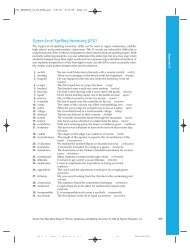Continuum for Opinion/Argument Writing â Eighth Grade S tru cture
Continuum for Opinion/Argument Writing â Eighth Grade S tru cture
Continuum for Opinion/Argument Writing â Eighth Grade S tru cture
Create successful ePaper yourself
Turn your PDF publications into a flip-book with our unique Google optimized e-Paper software.
S<strong>tru</strong><strong>cture</strong><br />
Overall<br />
Lead<br />
Transitions<br />
<strong>Grade</strong> 6<br />
(1 point)<br />
Not only did I stake a<br />
position that can be<br />
supported by a variety of<br />
<strong>tru</strong>stworthy sources, each<br />
part of my text builds my<br />
argument and leads to a<br />
conclusion.<br />
I wrote an introduction<br />
that helps the reader to<br />
understand and care about<br />
the topic or text. I thought<br />
backwards between the<br />
piece and the introduction<br />
to make made sure that the<br />
introduction fits with the<br />
whole.<br />
Not only did I clearly state<br />
my claim, I named the<br />
reasons that I’ll be<br />
developing later. I also<br />
told my reader how my<br />
text will unfold.<br />
I used transitional phrases<br />
to help my readers<br />
understand how the<br />
different parts of my piece<br />
fit together to support my<br />
argument.<br />
1.5<br />
pts<br />
<strong>Continuum</strong> <strong>for</strong> <strong>Opinion</strong>/<strong>Argument</strong> <strong>Writing</strong> – <strong>Eighth</strong> <strong>Grade</strong><br />
Updated 10/4/12<br />
2.5<br />
<strong>Grade</strong> 7<br />
(2 points)<br />
I not only staked a position that<br />
can be well-supported by a<br />
variety of evidence, I also<br />
considered positions on the topic<br />
or text that might disagree with<br />
my own position. I built to a<br />
conclusion which still let readers<br />
know that my own position is<br />
valid and makes sense.<br />
Not only did I make sure that my<br />
introduction fits with the whole<br />
of my piece, I also considered<br />
how best to angle the<br />
in<strong>for</strong>mation I give about the<br />
topic or text in order to get the<br />
reader ready to see my point.<br />
I made it clear to readers what<br />
my piece will argue.<br />
I used transitions to make it clear<br />
when I am staying with one line<br />
of thinking and when I am<br />
following or refuting another.<br />
Transitions such as <strong>for</strong> instance,<br />
in addition, also, and there<strong>for</strong>e<br />
help my reader stay with one<br />
line of thinking. Transitions such<br />
as nevertheless, on the other<br />
hand, let my reader know when I<br />
am moving to a different line of<br />
thinking.<br />
pts<br />
<strong>Grade</strong> 8<br />
(3 points)<br />
I not only presented an argument<br />
and laid out different aspects of the<br />
argument, I also stayed fair to those<br />
who might disagree with me by<br />
helping readers understand evidence<br />
against my position. I still held to<br />
my position and built to a<br />
conclusion which rein<strong>for</strong>ces why my<br />
particular position is valid and<br />
significant.<br />
In my introduction I am strategic<br />
and fair. I helped the reader get a<br />
sense of the importance of this<br />
argument as well as some of the<br />
debates taking place around it. Yet, I<br />
am strategic about how I provided<br />
this context and decided carefully<br />
about what to include and how to<br />
present the in<strong>for</strong>mation.<br />
My introduction clearly lays out my<br />
line of argument, making it clear<br />
that my position is different from<br />
others.<br />
Not only do I use transitions to<br />
make clear how evidence is linked<br />
to lines of thinking, I used<br />
transitions to create connections and<br />
to separate lines of thinking or<br />
propose alternate evidence.<br />
3.5<br />
pts<br />
Midlevel<br />
Midlevel<br />
Midlevel<br />
Midlevel<br />
Midlevel<br />
Midlevel<br />
Midlevel<br />
Midlevel<br />
Midlevel<br />
<strong>Grade</strong> 9/10<br />
(4 points)<br />
I not only presented different aspects of<br />
an argument, I also was fair to all<br />
positions, showing gaps or limitations of<br />
each, including my own. I made it clear<br />
how my position was unique, and I built<br />
to a conclusion that shows my position<br />
as perhaps not perfect but significant<br />
and valid.<br />
Not only did I make deliberate decisions<br />
about how to provide in<strong>for</strong>mation in my<br />
introduction that orients the reader and<br />
gets the reader ready to follow my line<br />
of thinking, I also refer to the<br />
introduction later in order to heighten<br />
the effect of the argument as a whole.<br />
My introduction clearly lays out my line<br />
of argument, making it clear that my<br />
position is different from others.<br />
My transitions connected examples to<br />
reasons and evidence, and help the<br />
reader follow my lines of thinking. I<br />
also used transitions which make clear<br />
the relationship of these sources to each<br />
other and to my own claim. I used<br />
phrases such as in accordance with, in<br />
conjunction with, similar to, by contrast.<br />
Score<br />
(Elaboration and Description are double weighted categories. Whatever score a student would get in these categories is worth double the amount of points. Ex. if a student exceeds expectations in Elaboration, then that<br />
student would receive 8 points instead of 4 points. If a student meets standards in Elaboration, then that student would receive 6 points instead of 3 points, and so on.)<br />
©Units of Study <strong>for</strong> Teaching <strong>Writing</strong>, <strong>Grade</strong> by <strong>Grade</strong>: A Yearlong Workshop Curriculum, <strong>Grade</strong>s K-8,<br />
by Lucy Calkins and Colleagues (Heinemann, 2013/2014)<br />
For distribution only in TCRWP schools<br />
DRAFT
Ending<br />
Organization<br />
I wrote a conclusion that<br />
restates the main points of<br />
the essay and may offer a<br />
lingering thought or new<br />
insight <strong>for</strong> readers to<br />
consider. The ending adds<br />
to and strengthens the<br />
overall argument.<br />
I arranged paragraphs,<br />
reasons and evidence<br />
purposefully, leading<br />
readers from one claim or<br />
reason to another. I wrote<br />
more than one paragraph<br />
to develop a claim or<br />
reason.<br />
<strong>Continuum</strong> <strong>for</strong> <strong>Opinion</strong>/<strong>Argument</strong> <strong>Writing</strong> – <strong>Eighth</strong> <strong>Grade</strong><br />
In the conclusion, I returned to<br />
the sides of the argument and<br />
reiterated how the support <strong>for</strong><br />
my claim outweighed the<br />
counterclaim.<br />
I grouped my reasons and<br />
related evidence into paragraphs.<br />
The parts of my piece are<br />
arranged purposefully to best<br />
suit my purpose. I may have<br />
used compare/contrast, order of<br />
importance or sequence as<br />
organizing s<strong>tru</strong><strong>cture</strong>s in my<br />
piece.<br />
Updated 10/4/12<br />
In the conclusion, I returned to the<br />
context and significance of the<br />
argument and reiterated the<br />
significance of my claim, showing<br />
why it is valid.<br />
I grouped my reasons and related<br />
evidence into paragraphs that are<br />
organized in a logical, compelling<br />
order. I have been purposeful not<br />
just in how I organized the evidence<br />
to support my claim but also in how<br />
I organized the parts of my piece<br />
that discuss alternate or opposing<br />
claims.<br />
Midlevel<br />
Midlevel<br />
Midlevel<br />
In the conclusion I acknowledged the<br />
complexity of the argument and argue<br />
<strong>for</strong> the significance, impact, or potential<br />
of my claim.<br />
I have a purpose <strong>for</strong> how I chose to<br />
organize each part of my piece, what I<br />
chose to include/exclude, (including<br />
citations and acknowledgement of other<br />
views), and where I chose to include<br />
each detail in my piece.<br />
I distinguished between parts of<br />
the text that support the claim<br />
and parts that acknowledge<br />
and/or refute a counterclaim.<br />
Total<br />
Development<br />
Elaboration<br />
<strong>Grade</strong> 6<br />
(1 point)<br />
I included and arranged a<br />
variety of evidence to<br />
support my reasons.<br />
I used <strong>tru</strong>sted sources<br />
and in<strong>for</strong>mation from<br />
authorities on the topic.<br />
I explained how my<br />
evidence strengthens my<br />
argument. I explain<br />
exactly which evidence<br />
supports which point.<br />
<strong>Grade</strong> 7<br />
(2 points)<br />
I developed a variety of reasons,<br />
supported by evidence, to argue<br />
my claim. These reasons and<br />
evidence are supported by<br />
detailed, precise examples.<br />
I included <strong>tru</strong>stworthy and<br />
significant sources and analyzed<br />
the relevance of these sources.<br />
I related textual evidence back to<br />
my argument and make it clear<br />
how it strengthens my claim.<br />
<strong>Grade</strong> 8<br />
(3 points)<br />
My reasons are clearly stated and<br />
fully developed, with convincing,<br />
cited evidence and analysis. I link<br />
text evidence back to my reasons<br />
and claim.<br />
I included valid, significant, and<br />
diverse sources and analyzed the<br />
relevance and validity of these<br />
sources, including how they<br />
persuade their audience. I explain<br />
when a source seems problematic,<br />
such as when it exaggerates or<br />
introduces red herrings, misleading<br />
in<strong>for</strong>mation or statistics.<br />
1.5<br />
pts<br />
Midlevel<br />
2.5<br />
pts<br />
Midlevel<br />
3.5<br />
pts<br />
Midlevel<br />
<strong>Grade</strong> 9/10<br />
(4 points)<br />
I supported each of my claims, stating<br />
the reasons clearly and supporting these<br />
reasons with cited evidence and<br />
convincing analysis.<br />
I evaluated my sources’ reasoning,<br />
authenticity and rhetoric. I explained<br />
when a source seemed problematic, such<br />
as when examples suggested as<br />
generalizable are actually specific.<br />
I related evidence back to my claim,<br />
situated it contextually, and explained<br />
its relevance and significance. The<br />
content is persuasive <strong>for</strong> my audience.<br />
Score<br />
(x2)<br />
(Elaboration and Description are double weighted categories. Whatever score a student would get in these categories is worth double the amount of points. Ex. if a student exceeds expectations in Elaboration, then that<br />
student would receive 8 points instead of 4 points. If a student meets standards in Elaboration, then that student would receive 6 points instead of 3 points, and so on.)<br />
©Units of Study <strong>for</strong> Teaching <strong>Writing</strong>, <strong>Grade</strong> by <strong>Grade</strong>: A Yearlong Workshop Curriculum, <strong>Grade</strong>s K-8,<br />
by Lucy Calkins and Colleagues (Heinemann, 2013/2014)<br />
For distribution only in TCRWP schools<br />
DRAFT
I acknowledged different<br />
sides to this argument.<br />
<strong>Continuum</strong> <strong>for</strong> <strong>Opinion</strong>/<strong>Argument</strong> <strong>Writing</strong> – <strong>Eighth</strong> <strong>Grade</strong><br />
Not only did I acknowledge<br />
counterclaims while being<br />
careful to separate them from my<br />
claim, I can also say which facts<br />
and details make the claim<br />
strongest.<br />
Updated 10/4/12<br />
I related evidence back to the<br />
context and significance of the<br />
argument and my claim. The content<br />
is appropriate to my audience.<br />
Not only did I acknowledge sides<br />
and counter-claims, I also develop<br />
how they are related to and/or<br />
different from my claim.<br />
I acknowledged complexity, describing<br />
various sides, stances, and perspectives<br />
and elaborating on the strengths,<br />
assumptions, and limitations in all<br />
positions, including my own. I<br />
contextualized my claim within these<br />
various perspectives.<br />
Description<br />
I chose words deliberately<br />
to be clear and to have an<br />
effect on my reader.<br />
I reached <strong>for</strong> precise<br />
phrases, metaphors,<br />
analogies or images that<br />
would help to convey my<br />
ideas and strengthen my<br />
argument.<br />
I chose how to present<br />
evidence and explained<br />
why and how the evidence<br />
supports my claim.<br />
I used shifts in my tone to<br />
help readers follow my<br />
argument, and I made my<br />
piece sound serious<br />
I do not just rely on buzz words<br />
to evoke emotion from the<br />
reader (e.g. it is dangerous,<br />
critical, horrible), I chose precise<br />
words and used some analogies<br />
or comparisons to explain what I<br />
mean and to achieve an intended<br />
effect. I cut any words that do<br />
not help me get my meaning<br />
across exactly.<br />
I considered different meanings<br />
of words, including technical<br />
and figurative, and thought<br />
about the impact of specific<br />
words on the mood and tone of<br />
my piece.<br />
Not only did I make choices<br />
about how to give my evidence,<br />
I also made choices about the<br />
way I analyze the evidence to<br />
get readers to follow my line of<br />
thinking.<br />
Not only have I matched the<br />
tone of parts of my argument to<br />
the meaning and purpose of that<br />
part, changing my tone<br />
deliberately to match my<br />
content, I have also used<br />
consistently <strong>for</strong>mal tone.<br />
Rather than only appealing to<br />
emotions, I showed readers that my<br />
evidence is sufficient and makes<br />
sense. I do have intended effects on<br />
the reader in mind, and these are<br />
accomplished through the way I<br />
presented and analyzed the<br />
evidence.<br />
I considered multiple meanings and<br />
nuances of words in order to include<br />
words and phrases, including<br />
comparisons, allusions and<br />
analogies, to effect the mood and<br />
tone of the piece.<br />
I angled my evidence and my<br />
analysis of evidence and sources to<br />
support my claim.<br />
My tone is consistently <strong>for</strong>mal. I<br />
matched the tone of my argument to<br />
the content, part by part, adopting a<br />
reasoning, or challenging, or<br />
sympathetic tone.<br />
Midlevel<br />
Midlevel<br />
Midlevel<br />
Not only did I use analogies,<br />
comparisons, symbolism and allusions<br />
to make my points and consider how<br />
word choice and the content of my piece<br />
will have an effect on my reader, I also<br />
considered how the way my piece reads<br />
will affect the reader. I used words and<br />
syntax to make my work more powerful.<br />
I used words precisely, and/or<br />
figuratively, and/or symbolically, to<br />
strengthen a particular tone or meaning.<br />
I angled evidence and represented<br />
various perspectives to support and<br />
situate my claim<br />
My tone is appropriate <strong>for</strong> the purposes<br />
of each part of my piece and in keeping<br />
with the discipline within which I am<br />
writing<br />
(x2)<br />
(Elaboration and Description are double weighted categories. Whatever score a student would get in these categories is worth double the amount of points. Ex. if a student exceeds expectations in Elaboration, then that<br />
student would receive 8 points instead of 4 points. If a student meets standards in Elaboration, then that student would receive 6 points instead of 3 points, and so on.)<br />
©Units of Study <strong>for</strong> Teaching <strong>Writing</strong>, <strong>Grade</strong> by <strong>Grade</strong>: A Yearlong Workshop Curriculum, <strong>Grade</strong>s K-8,<br />
by Lucy Calkins and Colleagues (Heinemann, 2013/2014)<br />
For distribution only in TCRWP schools<br />
DRAFT
<strong>Continuum</strong> <strong>for</strong> <strong>Opinion</strong>/<strong>Argument</strong> <strong>Writing</strong> – <strong>Eighth</strong> <strong>Grade</strong><br />
Updated 10/4/12<br />
Total<br />
Language Conventions<br />
Spelling<br />
Punctuation<br />
<strong>Grade</strong> 6<br />
(1 point)<br />
I used resources to be sure<br />
the words in my writing<br />
are spelled correctly,<br />
including returning to<br />
sources to check spelling.<br />
I used punctuation such as<br />
dashes, colons,<br />
parentheses, and<br />
semicolons to help me<br />
include or connect extra<br />
in<strong>for</strong>mation in some of my<br />
sentences.<br />
<strong>Grade</strong> 7<br />
(2 points)<br />
I matched the spelling of<br />
technical vocabulary to that<br />
found in resources and text<br />
evidence. I spelled material in<br />
citations correctly.<br />
I used accurate citation. I used<br />
punctuation to clarify quotations<br />
and to emphasize meaning.<br />
<strong>Grade</strong> 8<br />
(3 points)<br />
I spelled technical vocabulary and<br />
literary vocabulary accurately. I<br />
spelled material in citations<br />
according to sources, and spelled<br />
citations accurately.<br />
I used full and accurate citation. I<br />
used punctuation to clarify and<br />
emphasize quotations and to<br />
enhance meaning.<br />
1.5<br />
pts<br />
Midlevel<br />
2.5<br />
pts<br />
Midlevel<br />
3.5<br />
pts<br />
Midlevel<br />
Midlevel<br />
Midlevel<br />
Midlevel<br />
<strong>Grade</strong> 9/10<br />
(4 points)<br />
My spelling was accurate throughout,<br />
including cited text and citations.<br />
I used punctuation to emphasize<br />
connections, strengthen tone, clarify<br />
relationships and meaning.<br />
Score<br />
Total<br />
Teachers, when this is totally finished, each category will refer to “the writer” rather than “I”. We are giving out these assessments so they can be used immediately, after giving the on demands, and<br />
they can be used with kids <strong>for</strong> self-assessment and setting goals. We have created these continua so you will have your own place to pull together scores of student work.<br />
(Elaboration and Description are double weighted categories. Whatever score a student would get in these categories is worth double the amount of points. Ex. if a student exceeds expectations in Elaboration, then that<br />
student would receive 8 points instead of 4 points. If a student meets standards in Elaboration, then that student would receive 6 points instead of 3 points, and so on.)<br />
©Units of Study <strong>for</strong> Teaching <strong>Writing</strong>, <strong>Grade</strong> by <strong>Grade</strong>: A Yearlong Workshop Curriculum, <strong>Grade</strong>s K-8,<br />
by Lucy Calkins and Colleagues (Heinemann, 2013/2014)<br />
For distribution only in TCRWP schools<br />
DRAFT
Scoring Guide:<br />
<strong>Continuum</strong> <strong>for</strong> <strong>Opinion</strong>/<strong>Argument</strong> <strong>Writing</strong> – <strong>Eighth</strong> <strong>Grade</strong><br />
Updated 10/4/12<br />
In each row, circle the descriptor in the column that matches the student work. Scores in the categories of Elaboration and Description are worth double the point<br />
value (2, 3, 4, 5, 6, 7,or 8 instead of 1, 1.5, 2, 2.5, 3, 3.5, or 4).<br />
Total the number of points, and track students’ progress by seeing when the total points increase.<br />
Total score: ________<br />
If you want to translate this score into a grade, you can use the provided table to score each student<br />
on a scale from 0 – 4.<br />
Number of Points<br />
Scaled Score<br />
1-11 1<br />
11.5-16.5 1.5<br />
17-22 2<br />
22.5-27.5 2.5<br />
28-33 3<br />
33.5-38.5 3.5<br />
39-44 4<br />
(Elaboration and Description are double weighted categories. Whatever score a student would get in these categories is worth double the amount of points. Ex. if a student exceeds expectations in Elaboration, then that<br />
student would receive 8 points instead of 4 points. If a student meets standards in Elaboration, then that student would receive 6 points instead of 3 points, and so on.)<br />
©Units of Study <strong>for</strong> Teaching <strong>Writing</strong>, <strong>Grade</strong> by <strong>Grade</strong>: A Yearlong Workshop Curriculum, <strong>Grade</strong>s K-8,<br />
by Lucy Calkins and Colleagues (Heinemann, 2013/2014)<br />
For distribution only in TCRWP schools<br />
DRAFT



